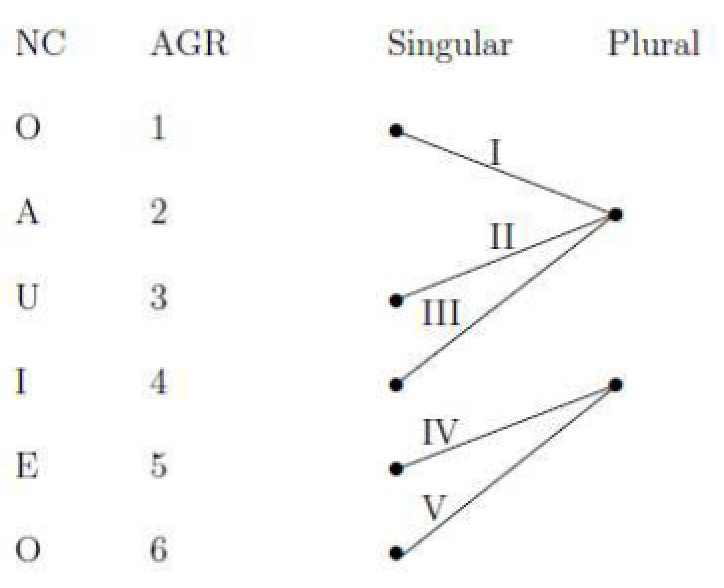While only some languages of the region still have a productive noun
class system (see Salffner (2009,
p.59-61) for Ukaan), most languages only exhibit traces, such
as the initial vowels in nouns. This is also the case in Abesabesi.
These initial vowels, former noun class prefixes, can represent an
affiliation to a semantic domain, mark number and give a distinction
between human and non-human. The former noun-class system is clearly
decaying, as most of these traits have become optional. Assuming the
quality of the initial vowel represented the affiliation to a certain
noun class, as it is the case in neighboring Ukaan, some semantic
domains can be spotted. Table 4.1 shows that most
lexical items denoting people start with an /o/ or /ɔ/, most
animals and all properties start with an /e/ or /ɛ/, and gerunds
all start with an /i/.
Table 4.1: Initial vowels matched with semantic domains
These former noun classes are also reflected in the human/non-human
distinction in the pronoun paradigms of Abesabesi. While the bound 3
SG pronoun for humans is ɔ́, the pronoun for non-humans is ɛ́. This distinction is also present in the
third person plural pronouns bà/bè/bò
(human) and í (non-human).
Number marking is another trace of the noun-class system. As discussed in
the previous section, human plural nouns start with an /a/, while non-human plural nouns start
with an /i/. Demonstratives and
property nouns both agree in number with the noun they modify. There is
only one instance of a property noun agreeing with a human noun by
switching the initial vowel to /o/
(see example 4.1).
Synchronically, Abesabesi's system has reduced to four classes,
distinguishing human from non-human and singular from plural (see Table
4.2). Agreement has been reduced to a
singular/plural distinction, while pronoun paradigms distinguish all
four classes.
Table 4.2: Synchronous analysis of noun classes
| Class | Prefixes | Agreement | Subject pronoun |
| Human Singular | mostly O- | E- | ɔ́ |
| Human Plural | mostly A- | I- | bà/bè/bò |
| Non-human Singular | A-/E-/I-/O- | E- | ɛ́ |
| Non-human Plural | I- | I- | í |
If we look at Ukaan, to compare Abesabesi to a productive noun class
system of the region, we can see many similarities amongst the noun
class prefixes (see Figure 4.1). For example, the
prefix for the first noun class including mostly humans is also O- and
its plural is A-. The other plural class has the prefix -I. In Abesabesi
and Ukaan, the ATR value is not critical
for the affiliation to noun classes, which is why capital letters are
used as archiphones. Ukaan's noun class system could be a possible
representation of what Abesabesi's system could have looked like before
it lost the agreement classes. This system is also similar to the Edoid
one. Elugbe (1989, p. 123)
reconstructs the five vocalic singular noun prefixes U-, I-, E-, O-, and
A- and two plural prefixes A- and I-.
Figure 4.1: Ukaan noun classes. (Salffner 2009, p.60)
